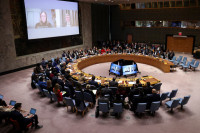Opinion
For the good of all
Prime Minister Sher Bahadur Deuba’s visit to India occurred about the same time as the announcement by President Donald Trump of US policy on Afghanistan and South Asia, the China-India standoff at Doklam and Chinese Vice Premier Wang Yang’s visit to Nepal.
Binoj Basnyat
Prime Minister Sher Bahadur Deuba’s visit to India occurred about the same time as the announcement by President Donald Trump of US policy on Afghanistan and South Asia, the China-India standoff at Doklam and Chinese Vice Premier Wang Yang’s visit to Nepal. India and Nepal have numerous shared concerns, but three urgent issues are integrating water resources for water and energy security, curbing terrorism for national and regional security, and promoting strategic connectivity.
India has been emerging as a regional power with added assurances by the Trump administration; former prime ministers Jawaharlal Nehru and Indira Gandhi made efforts to show that India was concerend with the South Asian region as part of its national security to protect foreign political interests through military, economic and political measures. Because of common religious, linguistic and ethnic ties with immediate neighbours, India’s regional power ambitions are often seen as a threat to their respective national identities. So all India’s neighbours used the strategy of internationalising their differences of opinion.
Multiple dimensions
Deuba’s visit has many dimensions judging from what was discussed with Indian Prime Minister Narendra Modi: constitutional amendment, flooding, construction of dams on the border and inequality in exploitation of resources. The joint statements and memorandums of understanding signed with India deal with political, economic (infrastructure, energy and water), education, health, cultural and security cooperation. Inviting Modi to inaugurate the Arun III hydro project is a shift to the fore in the production of hydroelectricity. About 70 percent of the water in Nepal flows unregulated for four months of the year. If it is dammed, 225 billion cubic metres of water can be stored. The topography allows Nepal and India and the people living in the Gangetic belt and Bangladesh to benefit from socio-economic development.
Chanting the mantra of hydropower potential of 83,000 MW for more than half a century is not sufficient. The mid-hills region has prospects for standard projects that merge with the four major river systems with high possibility of generating hydropower through large projects like the Sapta Gandaki, Koshi High Dam, Pancheshwor, Karnali Chisapani and Sapta Koshi. This scheme will produce water for irrigation and domestic use and 1 million GW hour of electricity.
The recently announced policy of the Trump administration may not look like it has a direct bearing on Nepal, but in actual fact it affects all the neighbouring states of China and India. A 2015 report on terrorism issued by the US Department of State said that 3,967 terrorist related attacks, more than 33 percent of the global total, took place in four South Asian countries: Afghanistan, Bangladesh, Indian and Pakistan. South Asia is the region from where the most threats to the US appear.
Strengthening systems
The South Asian Association for Regional Cooperation (Saarc) has set up a Terrorist Offences Monitoring Desk, Drugs Offences Monitoring Desk and expert group for networking between police authorities or Bimstec, but it has not been successful in controlling international terrorism, transnational organised crime and illicit drug trafficking. South Asia, which is home to 1.67 billion people, is the least integrated region in the world even though it shares cultural values, history and geography. Despite achieving an economic growth of 7.1 percent over the last decade, it has not been able to contribute enough due to historical political tensions, trust deficit, cross-border conflicts and security concerns.
India seems to view that this third visit by successive Nepali prime ministers in one and a half years has been more comfortable and rewarding from the geopolitical point of view. Nepal and India must find further ways and means to live and engage with each other with equity in many spheres: social, economic, political and security. Among the many arrangements the two countries have to deal with, water resources, strategic connectivity and national security are the most important and sensitive ones. Water is the most important natural resource that Nepal possesses, and it needs to be exploited for the benefit of India, Nepal and other countries on the subcontinent like Bangladesh.
Greater political instability in Nepal and the collapse and politicalisation of organisational dedication will impact both growing powers with a greater impact on India and its economic activities and global ambitions. Even if Nepal has not experienced major acts of terrorism, the open border with India is weakly controlled and illegal movement of goods and people is a common feature on both sides. Criminals commit crimes and cross the border to hide and escape punishment. Terrorists with illegal arms and ammunition can cross over easily, so international terrorist groups may use Nepal as a transit and possible staging point.
There is an opportunity to work hand in hand to curb and completely eradicate terrorists and their activities. Strengthening defence and security cooperation through the armies and law enforcement forces will bring about better understanding and commitment and better people-to-people contact. At a time when most people are aware of what is being drawn from the visit, a new strategic system with new management structures are necessary to curb terrorism and utilise the water resources with strategic connectivity for prosperity, stability, democracy and a more integrated South Asia in this globalised world.
Basnyat is a retired Army Major General, he holds an MPhil degree and is a political and security analyst




 5.81°C Kathmandu
5.81°C Kathmandu












